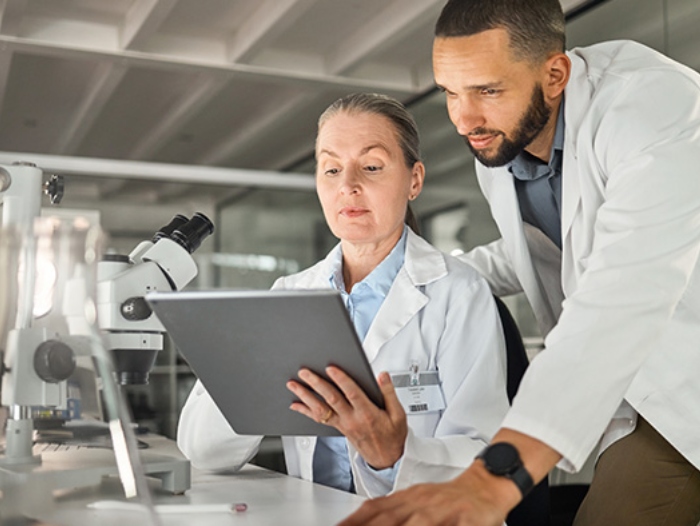Auto logout in seconds.
Continue LogoutAs hospitals continue to grapple with staffing shortages, some are turning to new artificial intelligence (AI) technology to reduce their nurses' workload and improve care for patients, Phil Galewitz writes for KFF Health News.
How the BioButton has helped improve care
In 2022, FDA cleared the use of BioIntelliSense's BioButton in adult patients who are not in critical care. The BioButton is a battery-controlled device that uses AI software to record patients' vital signs to detect signs that their condition is deteriorating. It sticks to patients' skin with an adhesive, is waterproof, and has a battery life of up to 30 days.
According to BioIntelliSense CEO James Mault, the BioButton is a huge advancement compared with nurses measuring patients' vital signs every few hours. "With AI, you now move from 'I wonder why this patient crashed' to 'I can see this crash coming before it happens and intervene appropriately,'" Mault said.
Hospitals that use the BioButton pay BioIntelliSense an annual subscription fee for the devices and software. Over the last year, the device has been used on more than 80,000 patients in dozens of hospitals nationwide.
Houston Methodist is one such hospital that is currently using the BioButton, and officials say the device has improved care and reduced nurses' workload since it was rolled out last year.
"Because we catch things earlier, patients are doing better, as we don't have to wait for the bedside team to notice if something is going wrong," said Sarah Pletcher, system VP at Houston Methodist.
Data from the BioButton is sent to the hospital's virtual monitoring center where nurses and technicians can view the health status of hundreds of patients. When the AI software detects readings outside of normal, it can alert staff members with a red checkmark by a patient's name. Then, staff members can check whether something else in the patient's condition can easily explain the anomaly or if bedside nurses need to be contacted.
According to Pletcher, the device reduces nurses' stress when monitoring patients and can allow some nurses to work more flexible hours since they can provide virtual care from home instead of at the hospital. The technology also allows nurses more time to provide more hands-on care, such as starting an intravenous line, she said.
Sheeba Roy, a nurse manager at Houston Methodist, said some members of the nursing staff had initially been concerned about relying on the BioButton and not checking patients' vitals themselves, but testing has shown that the device records information accurately.
"After we implemented it, the staff loves it," Roy said.
Patients who have used the device have also reported being happy with it. For example, Donald Eustes, a 65-year-old patient who has received care for prostate cancer and a stroke at the hospital, said he has no problem with the AI device helping his clinical team.
"You never know what can happen here, and having an extra set of eyes looking at you is a good thing," Eustes said. "… This sounds like a good use of artificial intelligence."
This year, Houston Methodist plans to expand the use of the BioButton by sending the device home with patients. The device will help the hospital track patients' progress in the weeks after they're discharged by checking their gait and tracking the quality of their sleep.
Some nurses are concerned about the technology
Despite positive feedback for the BioButton, some nurses are concerned that the technology could end up replacing them instead of supporting them, as well as potentially harming patients.
"The hype around a lot of these devices is they provide care at scale for less labor costs," said Michelle Mahon, an RN and an assistant director of National Nurses United, the largest nursing union in the United States. "This is a trend that we find disturbing."
Separately, Serena Bumpus, CEO of the Texas Nurses Association, said she's concerned the technology may be more burdensome for nurses and take time away from patients. "We have to be hypervigilant in ensuring that we are not leaning on this to replace the ability of nurses to critically think and assess patients and validate what this device is telling us is true," Bumpus said.
For its part, Houston Methodist hospital officials say they have not made any changes in nurse staffing since implementing the BioButton and have no plans to do so in the future because of the device. Pletcher also noted that the technology ultimately helps the hospital retain nurses instead of pushing them away.
"We are not going to need less nurses in health care, but we have limited resources and we have to use those as thoughtfully as we can," Pletcher said. "Looking at projected demand and seeing the supply we have coming, we will not have enough to meet demand, so anything we can do to give time back to nurses is a good thing." (Galewitz, KFF Health News, 5/8)
Innovative cross-continuum technologies, like AI and XR, are currently underutilized but have immense opportunity to shape patient care. Learn how to maximize the potential of these innovations and explore examples of their use in diagnostics, treatment, and management.
Don't miss out on the latest Advisory Board insights
Create your free account to access 1 resource, including the latest research and webinars.
Want access without creating an account?
You have 1 free members-only resource remaining this month.
1 free members-only resources remaining
1 free members-only resources remaining
You've reached your limit of free insights
Become a member to access all of Advisory Board's resources, events, and experts
Never miss out on the latest innovative health care content tailored to you.
Benefits include:
You've reached your limit of free insights
Become a member to access all of Advisory Board's resources, events, and experts
Never miss out on the latest innovative health care content tailored to you.
Benefits include:
This content is available through your Curated Research partnership with Advisory Board. Click on ‘view this resource’ to read the full piece
Email ask@advisory.com to learn more
Click on ‘Become a Member’ to learn about the benefits of a Full-Access partnership with Advisory Board
Never miss out on the latest innovative health care content tailored to you.
Benefits Include:
This is for members only. Learn more.
Click on ‘Become a Member’ to learn about the benefits of a Full-Access partnership with Advisory Board
Never miss out on the latest innovative health care content tailored to you.



